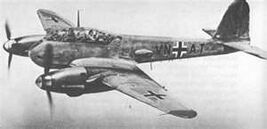
A Messerschmitt Me 210
The Messerschmitt Me 210 was a two-seat heavy fighter used by Germany during World War II.
==Description==
The first production model of the 210 series was the Me 210A-1 which was designed to serve asa heavy fighter. Powered by dual Daimler-Benz DB 601 Engines, the top speed was 563.2 km/h. Armament consisted of two 20mm MG 151s, two MG 17s, two MG 131s, and up to 1,000 kg of bombs.[1]
The Messerschmitt Me 210 was about 12.1 meters long with a wingspan of 16.4 meters. Empty weight was 7,070 kg. The service ceiling was about 7,000 meters.
Compared to the earlier Bf-110, the 210 featured a shorter and more compact nose offering a good field of vision. The 110's single rear gun was replaced with two FDL 131 remotely operated barbettes, each containing a single 13mm MG131 with 450 rounds per gun.[2]
Variants[]
The Me 210 had five different variants. The first one, the Me 210 A-0 was just a pre-production aircraft. The second one, the Me 210 A-1, was a single seated twin-engine fighter-bomber, and was also a heavy fighter. The third one was the Me 210 A-2, which also like the A-1, was a single seated twin-engine, but was a dive bomber and a heavy fighter as well. The fourth one, and the most used one, was the Me 210C, which possessed an improved airframe plus the Daimler-Benz DB 605 engines. The last variant, which was used by Hungary, was the Me 210Ca-1.
History[]
Development[]
Initial development of the 210 was started by Messerschmitt in 1938 at the request of the Luftwaffe, who wanted a successor for the Messerschmitt Bf 110. The new aircraft was to be a true multi role type with greater mission versatility and better defensive armament, allowing it to carry out heavy fighter, reconnaissance, attack and dive bombing missions.[3]
In the Summer of 1938, Messerschmitt submitted a design to the German Air Ministry. In the autumn the order was given for the start of the detailed design work, as well as the industrial requirements for production of 1,000 examples,[2] which were ordered off the drawing board following abandonment of the advanced Arado Ar 240.[4]

Messerschmitt Me-210
An outline of the Me 210s development
The first of the 15 prototypes and service test examples, D-AABF (c/n 2345),[4] was completed in the summer of 1939 and, powered by two DB601A engines, made its maiden flight on 2 September.[2] The poor handling of the aircraft, which included major directional and longitudinal instability, was found to be due to the design of the tail unit, which was replaced with a large single fin and tapered horizontal tail surfaces of greater span.[5] Despite these improvements, the second prototype crashed on 2 September 1940, while being used for flutter trials.[4]
Service[]
The first examples to enter service were a batch of Me 210A-0 pre production aircraft delivered during the later months of 1940 to Erprobungsgruppe 210, a unit specifically created to introduce the 210 into service with the Luftwaffe.[N 1]
The first unit to actively use the 210 was II./ZG I, based on the Eastern Front, which converted to the type in late 1941, but could rarely operate more that one third of the aircraft assigned to it.[6]
Following the type's withdrawal for modifications to improve it's flight characteristics, the 210 was reintroduced into service in July 1942 by Versuchsstaffel 210 based at Soesterberg in central Holland.[N 2] The type was later developed into the similar Messerschmitt Me 410.[7]
Notes[]
References[]
- ↑ http://www.wehrmacht-history.com/luftwaffe/fighters/messerschmitt-me-210-fighter.htm
- ↑ 2.0 2.1 2.2 Chant, Chris. 1999. Page 128.
- ↑ Chant, Chris. 1999. Page 127.
- ↑ 4.0 4.1 4.2 4.3 Kay, Antony L and J. R. Smith. Putnam. 2002. Page 255
- ↑ Chant, Chris. 1999. Page 129.
- ↑ 6.0 6.1 Kay, Antony L and J. R. Smith. Putnam. 2002. Page 256
- ↑ Chant, Chris. 1999. Page 158.
Bibliography[]
- Chant, Chris. German Warplanes of World War II. 1999. Spellmont Ltd. ISBN 1-86227-049-X
- Kay, Antony L and J R Smith. German Aircraft of the Second World War. Putnam Aeronautical Books. 2002. ISBN 0 85177 920 4
| ||||||||||||||
